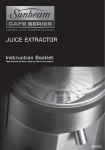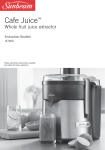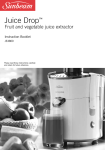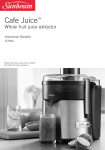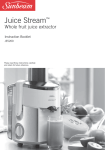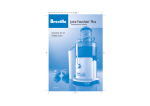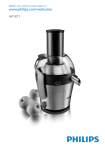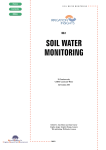Download Double Sieve Juicer
Transcript
Double Sieve Juicer Whole fruit juice extractor Instruction Booklet JE7800 Double Sieve Juicer Pro JE5600 Double Sieve Juicer Please read these instructions carefully and retain for future reference. Contents Safety Precautions for your Juicer 1 Features of your Double Sieve Juicer 2 Helpful hints for juicing 4 A guide to the benefits of juicing 5 Assembling your Double Sieve Juicer 7 Operating your Double Sieve Juicer 9 Juicing speed guide 10 Disassembling your Double Sieve Juicer 11 Care and Cleaning 12 Troubleshooting guide 13 Recipes14 Important instructions – retain for future use. Sunbeam’s Safety Precautions SAFETY PRECAUTIONS FOR YOUR SUNBEAM JUICER. • Do not put fingers or other objects into the feed chute whilst the juicer is in operation, always use the food pusher provided. • If any fruit or vegetables become lodged in the feed chute, use the food pusher or turn off the juicer, remove the plug from the power outlet and disassemble to remove the lodged fruit or vegetables. • Never operate without pulp container. • Ensure the juicer is correctly and completely assembled before turning the appliance ‘On’. • Switch off the appliance and disconnect from power supply before changing accessories or parts that move in use. • Ensure the juicer cover is fixed securely and pulp container is in place before juicer is turned on. Do not fasten the locking arm while the juicer is in operation. • Juicing blades are very sharp, handle Double Sieve filter basket with care when removing, replacing and cleaning. • Do not operate if Double Sieve filter basket is damaged. • Always operate the juicer on a flat, level surface. • Do not operate for more than 20 seconds at a time when juicing heavy loads. None of the recipes in this manual are considered a heavy load. Sunbeam is very safety conscious when designing and manufacturing consumer products, but it is essential that the product user also exercise care when using an electrical appliance. Listed below are precautions which are essential for the safe use of an electrical appliance: • Read carefully and save all the instructions provided with an appliance. • Always turn the power off at the power outlet before you insert or remove a plug. Remove by grasping the plug - do not pull on the cord. • Turn the power off and remove the plug when the appliance is not in use and before cleaning. • Do not use your appliance with an extension cord unless this cord has been checked and tested by a qualified technician or service person. • Always use your appliance from a power outlet of the voltage (A.C. only) marked on the appliance. • This appliance is not intended for use by persons (including children) with reduced physical, sensory or mental capabilities, or lack of experience and knowledge, unless they have been given supervision or instruction concerning use of the appliance by a person responsible for their safety. • Children should be supervised to ensure that they do not play with the appliance. • The temperature of accessible surfaces may be high when the appliance is operating. • Never leave an appliance unattended while in use. • Do not use an appliance for any purpose other than its intended use. • Do not place an appliance on or near a hot gas flame, electric element or on a heated oven. • Do not place on top of any other appliance. • Do not let the power cord of an appliance hang over the edge of a table or bench top or touch any hot surface. • Do not operate any electrical appliance with a damaged cord or after the appliance has been damaged in any manner. If damage is suspected, return the appliance to the nearest Sunbeam Appointed Service Centre for examination, repair or adjustment. • For additional protection, Sunbeam recommend the use of a residual current device (RCD) with a tripping current not exceeding 30mA in the electrical circuit supplying power to your appliances. • Do not immerse the appliance in water or any other liquid unless recommended. • Appliances are not intended to be operated by means of an external timer or separate remote control system. • This appliance is intended to be used in household and similar applications such as: staff kitchen areas in shops, offices and other working environments; farm houses; by clients in hotels, motels and other residential type environments; bed and breakfast type environments. If you have any concerns regarding the performance and use of your appliance, please visit www.sunbeam.com.au or contact the Sunbeam Consumer Service Line. Ensure the above safety precautions are understood. 1 Stainless steel Double Sieve filtering basket The Double Sieve filtering basket is designed to extract more juice from fruit and vegetables. The blades and basket are constructed with die-cast metal and fitted with stainless steel photo-etched mesh for durability, performance and cleaning ease. 2 Litre external pulp container Large 2 litre capacity pulp container is ideal for extracting large volumes of juice without stopping. Once full the pulp container can be easily removed without having to dismantle the juicer. Control dial with two speeds and off Two-speed electronic control with 1000 watt motor maximises juicing results. ‘Soft and Squeezy’ speed for soft fruits with high water content including oranges and watermelon. ‘Hard and Crunchy’ speed for harder and fibrous fruit and vegetables such as apples, ginger, celery and carrots Cord wrap Cord wraps away to keep bench top clean. Juicing jug Large 1 litre juicing jug with froth separating lid ensuring an easy pour and a smooth tasting juice. Cleaning brush Helps makes cleaning the filter basket easy. Simply wash under running water whilst pulp is still moist. 3 Helpful hints for juicing Preparing fruit and vegetables Wash all fruit and vegetables well before juicing. There is no need to peel vegetables that have a thin skin but a light scrub with a clean sponge will help rid of any dirt that may be stuck on or any waxy coatings. Peel fruit and vegetables that have a thick skin such as melons, pineapple and citrus fruit. Juice only the freshest of fruit and vegetables to get the most nutrients out of them and the best flavours. Cut large pieces of fruit, such as melons into large wedges. Some seeds from citrus fruits can be bitter so you may want to remove some of the seeds before juicing. Remove seeds and stones from fruit such as mangoes, papaya and stone fruit. This will prevent the blade from getting damaged. Juicing techniques When juicing different fruit and vegetables it may help to juice in different combinations. For example, when juicing apples and oranges, juice the soft fruit (oranges) first, then follow with the hard fruit (apples) second. This will help you to achieve the maximum juice extraction from the fruit and vegetables. When juicing fresh herbs such as mint or parsley, add the herbs in between the fruit and vegetables to get the most out of the herb or if only using a small quantity, add the herb at the same time as a piece of fruit and vegetable. 4 Bananas can be hard to juice but the taste goes a long way. When juicing a blend of fruit with bananas, add the banana as either the first or second piece of fruit. The nectar of the banana will sit inside the filtering basket and as the remaining fruits are added into the juice extractor they will release the banana nectar throughout the rest of the juice resulting in frothy flavoursome juice. When juicing small fruit such as grapes or strawberries, add the fruit in handfuls rather than one at a time, this will maximise the amount of juice extracted. Be aware that beetroot stains all other fruit and vegetables. If juicing several different juice combinations, juice the drink with the beetroot last, so as to not stain the other drinks. A guide to the benefits of juicing Benefits KJ per 100g Fruit / Vegetable Source of Apples Carotenes, pectin, potassium, May help in the treatment vitamin C and dietary fibre, of constipation. energy giving carbohydrates. 150kj/100g Apricots Beta-carotene, iron, vitamin C, High in natural sugars for energy. dietary fibre. 280kj/100g Banana Potassium, carbohydrates, Provides sustained energy. dietary fibre, vitamin B6, vitamin C. 225kj/100g Beetroot Folate, potassium, leafy tops are rich The folate is excellent for in beta carotene, calcium and iron. healthy cells. 120kj/100g 200kj/100g Blueberries Carotenoids, vitamin C. Antibacterial. Capsicum High in vitamin C, beta carotene. 1 red capsicum has enough vitamin C 135kj/100g to meet the daily needs of 10 people. Carrots Beta carotene, folate, dietary fibre. May help with night vision. 100kj/100g Celery Only small amounts of vitamins and minerals. Helps to clean mouth and teeth. 50kj/100g Cherries Very high in vitamin C, dietary fibre. May help to stabilise the heartbeat and also keeps the skin healthy. 170kj/100g Cucumber Only small amounts of vitamins and minerals. May help with flatulence. 30-50kj/100g Fennel Beta carotene, folate. Fennel seeds are good for digestion. 50kj/100g Ginger Aids in digestion and is good for nausea and improves circulation. Grapefruit Rich in vitamin C, fibre, bioflavenoids. Pink grapefruit contains Lycopene 110kj/100g which is an anti-cancer agent and may reduce the risk of prostate cancer. Honeydew Melon Vitamin C, small amounts of carotenoids. May stimulate the kidneys to help function better. Kiwi Fruit Beta carotene, vitamin C, bioflavenoids, dietary fibre. Helps in digestion and cleansing of the skin. Lemon Bioflavenoids, limonene, pectin, vitamin C. The pectin may help reduce blood cholesterol. 95kj/100g Lime Bioflavenoids, limonene, pectin, vitamin C. The pectin may help reduce blood cholesterol. 90kj/100g Mandarins Vitamin C, beta carotene, folate, 130kj/100g 180kj/100g Vitamin C helps build the 165kj/100g immune system 5 A guide to the benefits of juicing (continued) Fruit / Vegetable Source of Mango Beta carotene, potassium, flavenoids Easy to digest. and other antioxidants. Benefits Mint Antispasmodic volatile oils, Aids digestion. flavenoids, menthol. Oranges High in vitamin C, fibre, beta carotene, flavenoids, thiamine, pectin, folate. Papaya Protective carotenoids, rich in Helps digest proteins. vitamin C, fibre, rich in papain. Parsley Vitamin C, iron. Pawpaw Beta carotene, flavenoids, Helps digest proteins. magnesium, rich in papain. Peaches Good source of vitamin C, dietary fibre, beta carotene. Easy to digest and works as a gentle 130kj/100g laxative. Pears Very good source of dietary fibre. Provide a quick source of energy. Pineapple Vitamin C, dietary fibre, beta carotene. Helps to digest protein. 160kj/100g Plums Vitamin E, potassium, beta carotene, May help to retard the effects malic acid. of wrinkling. 110-155kj/100g Raspberries High in dietary fibre, excellent source Helps in treating constipation. of vitamin C, some folate. 110kj/100g Rockmelons Excellent source of vitamin C, beta carotene, carotenoids. Spinach Zeaxanthin, vitamin C, beta carotene, Helps in keeping eyes healthy folate, dietary fibre. in the elderly. 235kj/100g Excellent for healthy skin and helps 100kj/100g the body’s defences against bacterial infections. 160kj/100g Excellent for fresh breath. 163kj/100g 190kj/100g May help in the prevention of cancer 90kj/100g and heart disease. Strawberries Vitamin C, dietary fibre, some folate. Helps to absorb iron better after eating meat. 6 KJ per 100g 65kj/100g 80kj/100g Tomatoes Rich in lycopene, vitamin C, and small amounts of vitamin E, folate, dietary fibre. May help reduce the risk of prostate 55kj/100g cancer in men. Watercress Vitamin C & E, folate, beta carotene, Thought to have cancer fighting iron. properties. 72kj/100g Watermelon Carotenoids, beta carotene, vitamin C, May stimulate the kidneys to help dietary fibre. function better. 95kj/100g Assembling your Sunbeam Double Sieve Juicer Before Use After unpacking your Double Sieve Juicer we recommend that you dissemble the unit before using for the first time. Wash all parts except the motor base in hot soapy water. Rinse and dry immediately. Important: Always ensure your juicer is unplugged from the power outlet when not in use, during assembling or whilst removing parts. 1.Set the motor base on a dry, level surface. For convenience when juicing, have the control switch facing you – figure 1. 3.Position the stainless steel double sieve filtering basket onto the motor drive shaft and push down until firmly in place – figure 3. Important: Ensure that the card disc protecting the Double Sieve filter basket blades is removed before use. Figure 3 4.Place the juicer cover onto the juice collector / bowl, with the feed chute positioned over the stainless steel double sieve filtering basket and push into position – figure 4. Figure 1 2.Place the juice collector / bowl onto the top of the motor base – figure 2. Figure 4 Figure 2 7 Assembling your Sunbeam Double Sieve Juicer (continued) 5.Secure the juicer cover by raising the locking arm and securing into the grooves on the juicer cover – figure 5. 7.Take the food pusher, align the groove on the food pusher with the notch on the inside of the feed chute and slide the food pusher down into the feed chute – figure 7. Figure 7 8.Position the juicing jug under the spout – figure 8. Figure 5 6.Slightly tilt the pulp container and slide into place under the juicer cover – figure 6. Tip: To reduce cleaning we recommend that you line the pulp container with a plastic bag to collect the pulp. Figure 8 Figure 6 8 Operating your Sunbeam Double Sieve Juicer Important: Do not operate for a total period longer than 20 minutes per session. Note: The Double Sieve Juicer should be completely assembled before use, if this is not the case see ‘Assembling your Double Sieve Juicer’ on page 7. 1.Ensure the control dial on the juicer is in the central ‘Off’ position and insert the power cord into a 230-240V AC power outlet and turn the power to ‘On’. 2.Clean fruit and vegetables thoroughly, ready for juicing. Note: The large feed chute allows whole fruit and vegetables to be juiced, however some fruit and vegetables may require other preparation before juicing, such as peeling or removing stones, see ‘Juicing speed guide’ on page 10 for our recommendations. 3.Ensure that the juicer has been assembled correctly, making sure that the stainless steel double sieve filtering basket revolves properly before placing fruit and vegetables in the juicer. Note: The stainless steel double sieve filtering basket should be cleaned thoroughly before each use, see ‘Care and cleaning’ on page 12. Important: Do not operate for more than 20 seconds at a time when juicing heavy loads. None of the recipes in this manual are considered a heavy load. 6.With the juicer in operation, place the fruit and vegetables into the feed chute. Using the food pusher, guide the fruit and vegetables down the feed chute and onto the stainless steel blade. Tip: For maximum juice extraction, guide the food pusher down the feed chute in a slow downward motion. Important: Do not push fruit or vegetables into the feed chute with your fingers, always use the food pusher provided. 7.The juice from the fruit and vegetables will flow directly into the jug or glass and the pulp will be separated and collected in the pulp container. Important: When juicing be aware of the level of pulp in the pulp collection container, because if the container is overfilled this can cause damage to the appliance and prevent the juicer from operating correctly. 8.When juicing is complete ensure that the juicer is switched ‘Off’ and unplugged from the power outlet. 4.Place the juicing jug under the juice spout. 5.Select speed using the control dial. To select ‘Soft and Squeezy’ speed, turn the control dial to the left. To select ‘Hard and Crunchy’, turn he control dial to the right. For optimum juicing results, ‘Soft and Squeezy’ speed is primarily used for soft fruit and vegetables, particularly those with high water content and ‘Hard and Crunchy’ speed is ideal for hard and fibrous fruit and vegetables. A list of fruit and vegetables commonly used for juicing and their recommended juicing setting and specified in the ‘Juicing speed guide’ on page 10. 9 Juicing speed guide Not all fruit and vegetables should be juiced at the same speed. To maximise juicing results, soft fruits with high water content should be juiced at lower speeds and high speed is ideal for hard and fibrous fruit and vegetables. Soft and Squeezy Speed Kale Mint Spinach Watercress Grapes Broccoli Cabbage Sweet Potatoes Apricots – remove stone Mandarins – remove skin Banana – remove skin Mangoes – remove skin & seed Blueberries Oranges – remove skin Capsicum – remove seeds Pawpaw Cherries – remove pips Peaches - remove stone Cucumber Plums – remove stone Grapefruit – remove skin Raspberries Honeydew Melon – remove skin Rock Melon – remove skin Kiwi Fruit – remove skin Strawberries Lemon – remove skin Tomatoes Lime – remove skin Watermelon – remove skin Hard and Crunchy Speed 10 Apples Ginger Beetroot Papaya Carrots Pears Celery Pineapple – remove skin Fennel Pears Disassembling your Sunbeam Double Sieve Juicer 1.Turn the power ‘Off’ at the power outlet and unplug the cord. 2.Slightly tilt the pulp container and slide away from the juicer – figure 9. Figure 9 3.Grip the safety locking arm and pull downwards to release – figure 10. 4.Lift the juicer cover from the juice collector/bowl – figure 11. Figure 11 5.Place fingers under the rim of the stainless steel blade and filtering basket and lift out – figure 12. Figure 12 Figure 10 Important: Juicing blades are very sharp, handle juicing filter basket with care when removing, replacing and cleaning. 6.Lift the juice collector/bowl from the motor base – figure 13. Figure 13 11 Care and cleaning Note: Ensure that the juicer is unplugged from the power outlet prior to cleaning. Quick clean For easy cleaning, ensure that immediately after use that the juicer is disassembled and that each removable part is rinsed under running water, removing any wet pulp and then allow to air dry. Thorough cleaning Disassemble the juicer and place all removable parts aside, see ‘Disassembling your Double Sieve Juicer on page 11. Rinse the juice collector, juicer cover, pulp container and food pusher under running water and wash with warm, soapy water. Rinse well. 12 To clean the stainless steel double sieve filtering basket, hold under warm running water and using an cleaning brush, brush the outside of the basket first. Then with the basket still under running water, brush the inside of the basket in an anti-clockwise direction to remove the pulp. To ensure the stainless steel double sieve filtering basket is free of all remaining pulp, hold it to the light and ensure that the holes in the filtering basket are not blocked Important: Juicing blades are very sharp, handle juicing filter basket with care when removing, replacing and cleaning. Use a soft, damp cloth to wipe the motor base clean. To clean the motor base Clean the motor base of the juicer using a damp soft sponge with mild detergent and wipe over the appliance. Important: Never immerse the motor base in water or any other liquid. Troubleshooting guide Problem Possible cause What to do Juicer will not start when speed is selected. The juicer hasn’t been assembled correctly. See ‘Assembling your Double Sieve Juicer’ on page 7. The juicer motor appears to struggle during operation. Pulp container is full. Empty the pulp container. Pulp is caught in the juicer cover. Stop juicing, remove the juicer cover and clean out pulp. See ‘Disassembling your Double Sieve Juicer’ and ‘Care and Cleaning’ sections. Try a slower juicing action – guide the food pusher down the feed chute in a slow downward motion. Stainless steel double sieve filtering basket is blocked with excess pulp. After extended juicing of fibrous fruit and vegetables the mesh on the filtering basket may need to be cleaned. Stop juicing, disassemble the juice extractor and clean the filtering basket. See ‘Disassembling your Double Sieve Juicer’ and ‘Care and Cleaning’ sections. See ‘Juicing speed guide’ on page 10. The selected juicing speed is incorrect. You notice less juice coming Large amounts of highly fibrous fruit out of the juice spout. and vegetables have caused excess pulp to build up in the filtering basket. Stop juicing, disassemble the juice extractor and clean the filtering basket. See ‘Disassembling your Double Sieve Juicer’ and ‘Care and Cleaning’ sections. The juicer motor stops or will not start. The motor has been overloaded. Unplug the juicer, allow it to cool and press the re-set button located underneath the machine. 13 Recipes DETOX AND CLEANSING DRINKS All these juices help to cleanse toxins from the body. For all recipes in this section process all ingredients, in the order listed, through the juicer, stir and serve immediately. Carrot Cleanser Makes approx 6 cups Body Cleanser Makes approx 3 cups 5 sprigs fresh parsley 4 apples 3 stalks celery 1 cucumber 1 lemon, peeled 1 lime, peeled 5 carrots 2 stalks celery 2 cups kale 1 apple 1 beetroot, quartered Skin Refresher Makes approx 3 cups 4 carrots 1 apple 1 orange, peeled 1 red capsicum, cored and seeds removed The Purifier Makes approx 6 cups Potassium Juice Makes approx 3 cups 2 large cucumbers 1 pineapple, skin removed 1 bunch fresh mint 1 lemon, peeled 2cm piece ginger 2 cups kale 14 3 carrots 3 stalks celery 2 apples ½ bunch fresh parsley 2 cups spinach Recipes (continued) JUICE REMEDIES All these juices are rich in vitamins and minerals. A great way to start the day. For all recipes in this section process all ingredients, in the order listed, through the juicer, stir and serve immediately. Morning Starter Makes approx 4 cups 5 carrots 4 sprigs fresh mint 1 apple Mean Green Juice Makes approx 3 cups 3 apples 2 stalks celery 1 cucumber 2 cups spinach Tummy Calmer Makes approx 3 cups 4 apples 2 cups spinach 1 beetroot, quartered ½ small cabbage, quartered Green Vitamin C Makes approx 3 cups Spinach Energizer Makes approx 3 cups 4 stalks celery 3 apples 1 head broccoli, chopped 1 cucumber ¼ cup fresh parsley sprigs Refreshing Renewal Makes approx 3 cups 4 apples 1 cucumber 1 fennel bulb, quartered 1 bunch fresh mint 2cm piece ginger Ginger Root Boost Makes approx 3 cups 6 carrots 3 apples 1 lemon 2cm piece ginger 3 apples 1 baby fennel, quartered 1 cucumber 2 cups spinach The Flu Fighter Makes approx 3 cups 6 carrots 2 stalks celery 1 apple 1 bunch fresh parsley Immunity Booster Makes approx 3 cups 3 carrots 1 apple 1 beetroot, quartered 1 stalk celery 1 cucumber ½ bunch fresh parsley 15 Recipes (continued) FAMILY FAVOURITES Juices the entire family will enjoy. For all recipes in this section process all fruit and vegetables, in the order listed, through the juicer. Add any vanilla extract to the finished juice, stir and serve immediately. Apple Green Grape Makes approx 3 cups 5 apples 1 lemon, peeled Plum, Orange and Vanilla Juice Makes approx 4 cups 10 black plums, stone removed 6 oranges, peeled ½ teaspoon vanilla extract Tropical Slurp Makes approx 5 cups 3 oranges, peeled 1 mango, skin and stone removed 2 cups green grapes 1 pineapple, skin removed The Red Racer Makes approx 5 cups Mojito Juice Makes approx 4 cups 500g watermelon, skin removed 250g fresh raspberries 2 apples 2 oranges, peeled Minty Peach Makes approx 5 cups 3 peaches, stone removed 1 apple 1 lime, peeled ½ bunch fresh mint 16 1 apple 1 cucumber 1 lime, peeled ½ cup fresh basil ½ bunch fresh mint Recipes (continued) PULP RECIPES Don’t throw away the juicer pulp. The Test Kitchen has some great recipes that will ensure you utilize the entire fruit/vegetable! icing sugar to the butter. Continue to beat until light and all ingredients are well combined. Cover top and sides of cooled cake with icing. Serve. Serves: 10-12 Kale and Italian Sausage Tart Spinach can be used instead of kale, if desired. 2 cups plain flour Makes: 1 Tart 2 teaspoons baking powder 1 sheet premade short crust pastry 1 teaspoon ground cinnamon 1 tablespoon olive oil ½ teaspoon mixed spice 20g butter 4 eggs 2 onions, chopped Carrot and Pineapple Cake 1 ½ cups sunflower oil 2 cloves garlic, crushed 1 cup caster sugar 500g Italian sausages, roughly chopped ½ cup brown sugar 1 ½ cups kale pulp 1 cup carrot pulp ¼ cup white wine ½ cup pineapple pulp 3 eggs ½ cup walnuts, chopped ½ cup fresh ricotta Icing: Salt and freshly ground black pepper, to taste 250g butter, softened 1.Preheat oven to 180°C. Grease a 20cm round tart pan. 2.Roll pastry out into a 23cm circle and gently place in tart tin. Cover with baking paper and fill with uncooked rice. Bake for 10 minutes (Blind Baking). Remove baking paper and rice. Cook for a further 10 minutes or until base is golden. 3.Place oil and butter in a large frypan over medium heat. Add onion and garlic cooking for 3-4 minutes or until tender. Remove from pan. 4.Add sausage to the pan and cook for 2-3 minutes or until golden. Add kale and onion mixture to the pan. Pour in white wine and allow to reduce by half. Season to taste with salt and pepper. Set aside to cool. 250g cream cheese, softened 5 cups icing sugar 1.Preheat oven to 180°C. Grease and line a 23cm spring form cake pan with baking paper. 2.In a large bowl combine flour, baking powder, cinnamon and mixed spice. 3.Add eggs, oil, sugars and fruit pulp. Stir to combine. Gently fold through walnuts. 4.Pour into prepared pan and bake for 50-60 minutes until cooked. Remove from pan and allow to cool on a wire rack. 5.To make the icing, place butter and cream cheese in the bowl of an electric mixer. Beat until light and fluffy. Gradually add 17 Recipes (continued) 5.Stir egg and ricotta through the cooled mixture. Pour into prepared tart case and bake for 10-15 minutes or until cooked. Serve hot or cold. Spinach and Fetta Muffins Pear and Ginger Cake 2 ½ cups self-raising flour Serves: 8-10 1 cup spinach pulp 150g butter, melted ¼ cup grated parmesan cheese 1 cup brown sugar 1 ¹⁄³ cups milk ¼ cup milk 200g feta cheese, crumbled 3 eggs 90g butter, melted 1 ½ cups self-raising flour 1 egg 1 tablespoon ginger pulp 1.Preheat oven to 180°C. Lightly grease 12 x 1 cup capacity muffin pan. 2.In a large bowl combine flour, spinach and parmesan cheese. 3.In a separate bowl combine remaining ingredients, stirring until combined. 4.Pour wet ingredients into dry ingredients and fold until just combined. Divide mixture evenly into the muffin pan. Bake for 20 minutes or until cooked when tested. Remove from pan and allow to cool on a wire rack. ½ teaspoon ground cinnamon 2 cups pear pulp 1.Preheat oven to 180°C. Grease and line a 20cm cake pan with baking paper. 2.In a large bowl combine butter, sugar, milk and eggs. 3.To the bowl add remaining ingredients. Stir mixture until just combined. Pour into prepared pan. Bake for 1 hour or until cooked when tested. Remove from pan and allow to cool on a wire rack. 18 The spinach pulp in this recipe can be substituted with almost any vegetable pulp. Makes: 12 Recipes (continued) Chocolate Ginger Beetroot Cake Serves: 10-12 2 cups self raising flour ¾ cup dark cocoa 2 teaspoons ground cinnamon 1 cup beetroot pulp sides of the pan. Cool completely before icing. 7.For the icing, beat butter until pale and fluffy; slowly add icing mixture whilst still beating. Fold through melted chocolate until well blended. Spread evenly over cake. 2 teaspoons ginger pulp Apple Cake 300g butter, room temperature Serves: 8-10 2 cups caster sugar 2 ¾ cups plain flour 2 teaspoons vanilla extract 1 tablespoon baking powder 5 eggs 1 tablespoon ground cinnamon ²⁄³ cup milk 2 eggs For the chocolate icing: 2 cups apple pulp 2 cups caster sugar 250g unsalted butter, softened to room temperature 1 cup vegetable oil 1 cup icing sugar 1 cup walnuts, chopped 100g dark chocolate, melted ¼ cup orange juice 1.Preheat the oven to 170°C. Grease and line the base and sides of a 28cm spring form pan with baking paper. 2.Sift the flour, cocoa and cinnamon together. Fold through the beetroot and ginger. 3.Cream the butter, sugar and vanilla for 5 minutes, or until light and fluffy, regularly scrape down the sides of the bowl with a spatula. 4.Add the eggs one at a time, beating thoroughly in between each egg. 5.Fold the flour and beetroot mixture into the egg mixture alternatively with the milk until well combined. 6.Pour into prepared cake pan. Bake for 50 to 55 minutes or until cake is firm to the touch and slightly pulling away from the 3 teaspoons vanilla essence 1.Preheat oven to 180°C. Grease and line a 23cm cake pan with baking paper. 2.Sift flour, baking powder and cinnamon into a large bowl. 3.In a separate bowl combine remaining ingredients 4.Pour wet ingredients into flour and fold until just combined. Pour into prepared pan. Bake for 60 to 75 minutes or until cooked when tested. Remove from pan and allow to cool on a wire rack. 19 Notes 12 Month Warranty This Sunbeam product is covered by a 12 month replacement or repair warranty, which is in addition to your rights under the Australian Consumer Law (if your product was purchased in Australia) or New Zealand Consumer Guarantees Act (if your product was purchased in New Zealand). Should you experience any difficulties with your product during the warranty period, please contact our customer service line for advice on 1300 881 861 in Australia, or 0800 786 232 in New Zealand. Alternatively, you can send a written claim to Your warranty does not: • cover freight or any other costs incurred in making a claim, consumable items, accessories that by their nature and limited lifespan require periodic renewal (such as filters and seals) or any consequential loss or damage; or Sunbeam to: • cover damage caused by: Australia - power surges, power dips, voltage supply problems, or use of the product on incorrect voltage; Units 5 & 6, 13 Lord Street Botany NSW 2019 Australia New Zealand 26 Vestey Drive Mt Wellington, Auckland New Zealand Upon receipt of your claim, Sunbeam will seek to resolve your difficulties or, if the product is defective, advise you on how to obtain a replacement or refund. To assist us in managing warranty claims, we recommend you register your product as soon as practicable after purchase by creating a MySunbeam account on our website and send a copy of your original receipt to Sunbeam. In order to make a claim under our warranty, you must have the original proof of purchase documentation for the product and present it when requested . Should your product develop any defect within 12 months of purchase because of faulty materials or workmanship, we will replace or repair it, at our discretion, free of charge. A product presented for repair may be replaced by a refurbished product of the same type rather than being repaired. Refurbished parts may be used to repair the product. Our replacement or repair warranty only applies where a defect arises as a result of faulty material or workmanship during the warranty period. Your warranty does not cover misuse or negligent handling (including damage caused by failing to use the product in accordance with this instruction booklet), accidental damage, or normal wear and tear. - servicing or modification of the product other than by Sunbeam or an authorised Sunbeam service centre; - use of the product with other accessories, attachments, product supplies, parts or devices that do not conform to Sunbeam specifications; or - exposure of the product to abnormally corrosive conditions; or • extend beyond 3 months if the product is used in commercial, industrial, educational or rental applications. The benefits given to you by our warranty are in addition to other rights and remedies under law in relation to the product. In Australia our goods come with guarantees that cannot be excluded under the Australian Consumer Law. You are entitled to a replacement or refund for a major failure and for compensation for any other foreseeable loss or damage. You are also entitled to have the goods repaired or replaced if the goods fail to be of acceptable quality and the failure does not amount to a major failure. Our goods also come with guarantees that cannot be excluded under the New Zealand Consumer Guarantees Act. If your warranty claim is not accepted, we will inform you and if requested to do so by you, repair the product provided you pay the usual charges for such repair. You will also be responsible for all freight and other costs. Should your product require repair or service after the warranty period, contact your nearest Sunbeam service centre. For a complete list of Sunbeam’s service centres, visit our website or call our customer service line for advice on 1300 881 861 in Australia, or 0800 786 232 in New Zealand. Need help with your appliance? Contact our customer service team or visit our website for information and tips on getting the most from your appliance. In Australia Visit www.sunbeam.com.au Or call 1300 881 861 In New Zealand Visit www.sunbeam.co.nz Or call 0800 786 232 is a registered trademark. Made in China. Due to minor changes in design or otherwise, the product may differ from the one shown in this leaflet. © Copyright. Sunbeam Corporation Limited 2013. ABN 45 000 006 771 Units 5 & 6, 13 Lord Street Botany NSW 2019 Australia Unit 3, Building D 26 Vestey Drive Mt Wellington Auckland New Zealand Sunbeam Corporation is a division of GUD Holdings Ltd. 7/13

























